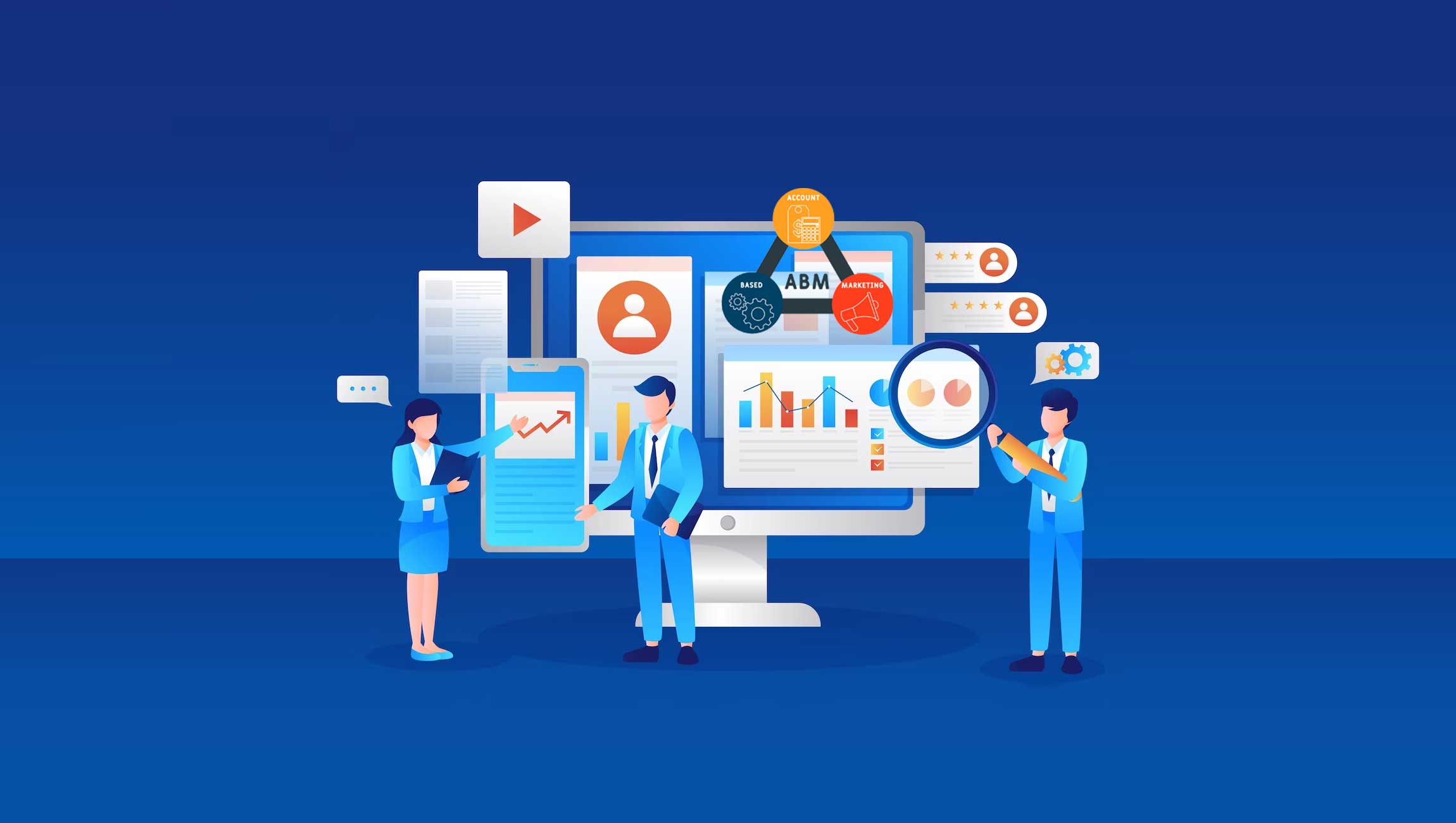
Cautious Steps in the Digital Age: Navigating Data Privacy and Ethics in AI Marketing
September 11, 2023
Casting a Wider Net: How Image and Video Recognition Is Revolutionizing AI Marketing
September 12, 2023In the rapidly evolving landscape of B2B marketing, staying ahead of the curve is essential. Traditional lead generation methods are needed to secure high-value B2B clients. Enter Account-Based Marketing (ABM) is a dynamic strategy gaining prominence due to its unparalleled ability to effectively target and engage critical accounts. In this extensive guide, we will delve deep into the intricacies of ABM, uncovering its immense potential and equipping you with a comprehensive roadmap to harness the full power of ABM in your B2B lead generation endeavours.

Introduction to Account-Based Marketing (ABM)
Account-Based Marketing (ABM) is not just a buzzword; it’s a fundamental shift in how B2B marketing is approached. Let’s start our journey by understanding the basics of ABM and its significance in the world of B2B lead generation.
Understanding the Basics of ABM
ABM represents a paradigm shift in marketing philosophy. Unlike traditional methods, where you cast a wide net to capture leads, ABM involves a laser-focused approach. Instead of pursuing a broad audience, ABM targets individual accounts or companies with personalized strategies. It’s like the difference between a shotgun blast and a precision-guided missile.
In essence, ABM is about quality over quantity. It centres on the belief that not all leads are created equal. Some accounts have substantial revenue and growth potential, making them far more valuable. By concentrating your marketing efforts on these high-potential accounts, you can achieve a higher return on investment (ROI).
ABM vs Traditional Marketing: A Comparative Analysis
To truly appreciate the power of ABM, it’s essential to compare it to traditional marketing approaches. Traditional marketing often involves creating generic content or advertisements and distributing them broadly, hoping to catch the attention of potential clients. It’s akin to fishing with a massive net, hoping to see something valuable amidst the abundance of fish.
In contrast, ABM is more akin to fishing with a spear. You know precisely which fish you want to catch and use highly targeted and personalized strategies to engage and convert them. This precision makes ABM incredibly effective in B2B lead generation.
Why ABM Matters in B2B Lead Generation
The B2B landscape often involves long, intricate sales cycles involving multiple decision-makers and stakeholders. In such an environment, ABM shines as a strategy. It allows you to build meaningful relationships with key decision-makers at your target companies. Instead of trying to convince a vast audience, you’re nurturing relationships with the individuals who hold the power to say “yes” to your solution.
ABM isn’t just about generating leads; it’s about developing suitable leads – those more likely to convert into paying customers. This emphasis on quality leads to higher conversion rates and increased revenue. Essentially, ABM is about working smarter, not harder, in your lead generation efforts.
The Evolution of ABM: From Concept to Strategy
Account-based marketing isn’t a new concept but has evolved significantly in recent years. What once started as a niche strategy for a select group of tech-savvy companies has become a mainstream approach for B2B marketers across various industries.
Technology, data, and evolving buyer behaviour drive the evolution of ABM. Modern ABM leverages powerful tools like predictive analytics and marketing automation to deliver personalized experiences at scale. It’s no longer a strategy reserved for Fortune 500 companies; businesses of all sizes can benefit from ABM’s effectiveness and efficiency.

Building the Foundation for Successful ABM
Account-based marketing is a more than one-size-fits-all approach. It requires careful planning and a solid foundation to yield the best results. This section will explore the critical steps in building this foundation.
Defining Your Ideal Customer Profile (ICP)
Your Ideal Customer Profile (ICP) is the compass for your ABM journey. It defines the characteristics of accounts that are most likely to become your best customers. These characteristics may include industry, company size, location, revenue, etc.
Creating a comprehensive ICP is akin to creating a roadmap for your ABM efforts. The more detailed and accurate your ICP, the easier it is to identify and prioritize the proper accounts to target. Think of it as a treasure map leading you to the charges with the most significant potential for conversion.
Identifying and Prioritizing Target Accounts
Not all high-value accounts are equal, and not all are ready to purchase simultaneously. To maximize the effectiveness of your ABM strategy, you need to identify and prioritize your target accounts carefully.
Using data, analytics, and insights, you can rank and prioritize your target accounts based on various factors. Consider elements like their current needs, engagement history with your brand, and alignment with your ICP. This prioritization ensures that your ABM efforts are laser-focused on the accounts with the highest potential for conversion, optimizing your ROI.
Crafting Compelling Value Propositions
In the world of ABM, personalization is king. Each target account is unique, and so should your value proposition. Your value proposition represents the tailored benefits and solutions you offer to address each account’s specific pain points and goals.
Think of your value proposition as the bait on your marketing hook. It should be so irresistible that your target accounts can’t help but bite. Personalization is the key here – show that you’ve done your homework and intimately understand their needs and challenges.
Aligning Sales and Marketing Teams for ABM Success
ABM is not a siloed marketing strategy; it’s a collaborative effort between your marketing and sales teams. Close alignment between these two departments is critical for ABM’s success.
Your sales team plays a pivotal role in identifying target accounts, providing valuable insights, and closing deals. Frequent communication and shared objectives between marketing and sales ensure everyone is on the same page and working cohesively to convert target accounts into satisfied customers.
In this section, we’ve laid the groundwork for successful ABM by defining your ICP, prioritizing target accounts, crafting compelling value propositions, and ensuring alignment between sales and marketing teams. Let’s explore the next crucial phase: creating personalized ABM campaigns tailored to your target accounts’ needs and preferences.

Creating Personalized ABM Campaigns
The heart of ABM lies in its ability to create customized experiences for your target accounts. This section delves into the strategies and tactics to craft compelling ABM campaigns that resonate with your audience personally.
Crafting Tailored Content for Target Accounts
When it comes to ABM, generic content won’t cut it. Each target account deserves tailored content that addresses their pain points, challenges, and aspirations. Whether it’s a blog post, whitepaper, or webinar, every piece of content should feel like it was created just for them.
Personalization goes beyond just using the recipient’s name in an email; it’s about understanding their unique needs and tailoring your messaging accordingly. It’s about showcasing how your solution can address their pain points and help them achieve their goals. Remember, when a target account feels understood and valued, they are more likely to engage with your content and move further down the sales funnel.
Leveraging Multichannel Marketing in ABM
ABM isn’t limited to a single marketing channel; it’s about reaching your target accounts wherever they are. This often involves leveraging multiple marketing channels, including email, social media, content marketing, and direct mail.
Multichannel marketing allows you to create a cohesive and immersive experience for your target accounts. For example, you might start by sending a personalized email introducing your solution, followed by targeted social media ads showcasing customer success stories. This multichannel approach keeps your brand top-of-mind and reinforces your value proposition.
The Role of Social Media in ABM Campaigns
Social media is a powerful tool in your ABM arsenal. It provides a platform for building relationships, sharing valuable content, and engaging with key decision-makers at your target accounts.
To harness the full potential of social media in ABM, you can:
- Identify and Follow Target Accounts: Monitor the social media profiles of your target accounts, engage with their content, and follow them. This keeps you updated on their activities and increases your brand visibility.
- Share Relevant Content: Share content specifically tailored to your target accounts’ interests and pain points. Whether it’s a thought leadership article or a case study showcasing similar companies’ success, ensure it resonates with your audience.
- Engage in Conversations: Don’t just be a passive observer. Engage in meaningful conversations with key stakeholders at your target accounts. Comment on their posts, ask insightful questions, and provide valuable insights.
Implementing Email Marketing Strategies
Email marketing remains a cornerstone of ABM campaigns. However, in ABM, the focus shifts from mass email blasts to highly personalized and targeted email communication.
Here are some key strategies for effective email marketing in ABM:
- Segmentation: Divide your target accounts into segments based on their needs, interests, and behaviour. Create tailored email content and messaging for each segment.
- Personalization: Personalize your emails with the recipient’s name, company name, and specific details that show you’ve done your research.
- Automation: Use marketing automation tools to trigger emails based on particular actions or milestones achieved by your target accounts.
- A/B Testing: Continuously optimize your email campaigns through A/B testing of subject lines, content, and calls to action.
- Follow-Up Sequences: Develop automated follow-up sequences that nurture leads and guide them through the sales funnel.

ABM Measurement and Analytics
ABM isn’t just about executing campaigns but also measuring their effectiveness and making data-driven improvements. This section will delve into the key metrics, tools, and ABM measurement and analytics strategies.
Setting Key Performance Indicators (KPIs) for ABM
Measuring the success of your ABM efforts starts with defining clear Key Performance Indicators (KPIs). These KPIs serve as benchmarks to evaluate the effectiveness of your campaigns and strategies.
Some common ABM KPIs include:
- Account Engagement Score: A score that measures the level of engagement of target accounts with your content and brand.
- Conversion Rate: The percentage of target accounts that move from one stage of the sales funnel to the next.
- Pipeline Contribution: The revenue generated or influenced by ABM campaigns.
- Customer Lifetime Value (CLTV): The long-term value that target accounts bring to your business.
By setting KPIs that align with your overall business goals, you can track the impact of your ABM efforts and make informed decisions to optimize your strategy.
The Importance of Marketing Automation in ABM
Marketing automation plays a pivotal role in the success of ABM. It enables you to execute personalized campaigns at scale, track user behaviour, and automate routine tasks.
Here’s how marketing automation enhances ABM:
- Personalization: Marketing automation tools allow you to personalize content and messaging for each target account based on their interactions with your brand.
- Lead Scoring: Automated lead scoring helps you identify which target accounts are most likely to convert, allowing you to prioritize your efforts effectively.
- Behaviour Tracking: Track how target accounts engage with your content and campaigns, providing insights into their interests and pain points.
- Lead Nurturing: Automate leads nurturing sequences to guide target accounts through the buying journey, delivering relevant content at the right time.
Analyzing ABM Campaign Data
Data is the lifeblood of ABM. It informs your decisions, highlights areas of improvement, and guides your strategy. In ABM, data analysis goes beyond just tracking basic metrics; it involves understanding the nuances of how your target accounts interact with your brand.
To effectively analyze ABM campaign data, consider the following:
- Account-Level Insights: Focus on the behaviour and engagement of individual target accounts rather than leads.
- Attribution Modeling: Understand how different touchpoints and interactions contribute to conversions and revenue.
- Content Performance: Analyze which content types and topics resonate most with your target accounts.
- Sales Alignment: Collaborate with your sales team to gather feedback on the quality of leads generated through ABM campaigns.
Continuous Improvement and Optimization
The beauty of ABM is its agility. You can continuously optimize your campaigns based on data insights to maximize results. This involves making data-driven adjustments to your messaging, content, targeting, and overall strategy.
Regularly assess your ABM campaigns, identify areas of improvement, and iterate on your tactics. Experiment with different messaging, content formats, and channels to find what resonates best with your target accounts. ABM is an ongoing process of refinement and enhancement.
This section explored the critical aspects of measuring and analyzing ABM campaigns, from setting KPIs and leveraging marketing automation to in-depth data analysis and continuous optimization. With robust measurement and analytics practices in place, you can refine your ABM strategy for even greater success.

Scaling Your ABM Efforts
Scaling your ABM efforts involves expanding beyond the initial pilot phase and reaching a broader audience of high-value accounts. This section will discuss the strategies, tools, and best practices for scaling your ABM initiatives.
Expanding ABM Beyond the Pilot Phase
Many organizations start their ABM journey with a pilot program targeting a select group of high-value accounts. While this approach is practical for testing and learning, true ABM success lies in scaling your efforts to reach a more extensive list of target accounts.
Here’s how to expand your ABM initiatives:
- Identify Additional Target Accounts: Continuously evaluate new high-value accounts aligning with your ICP.
- Leverage Technology: Invest in ABM-specific technology and tools that enable you to scale your campaigns efficiently.
- Replicate Success: Analyze the results of your pilot ABM campaigns and replicate the strategies that yield the best outcomes.
- Align Resources: Ensure that you have the necessary resources, including personnel and budget, to support your expanded ABM efforts.
Tools and Technologies for Scaling ABM
Scaling ABM requires the right tools and technologies to streamline processes and manage a growing list of target accounts. Some essential ABM tools include:
- Account-Based Advertising Platforms enable you to deliver targeted ads to specific accounts across various digital channels.
- Marketing Automation and CRM Integration: Seamless integration between your marketing automation and CRM systems ensures a unified view of target accounts and their interactions with your brand.
- Predictive Analytics: Predictive analytics tools help you identify potential high-value accounts by analyzing historical data and behaviour patterns.
- Content Personalization Engines: These tools enable dynamic content personalization at scale, ensuring your messaging remains highly relevant to each target account.
Overcoming Common Scaling Challenges
Scaling ABM can present its own set of challenges. Some common obstacles include:
- Resource Constraints: Expanding ABM efforts may require additional budget, personnel, and technology investments.
- Maintaining Personalization: As you reach a broader audience, maintaining the same level of personalization can be challenging.
- Alignment Across Teams: Ensuring your marketing and sales teams remain aligned becomes more critical as you scale.
- Data Management: Managing and analyzing data from a growing list of target accounts can become complex.
Organizations must develop scalable processes, invest in automation, and prioritize alignment and collaboration between teams to overcome these challenges.
Case Studies: Successful ABM Scaling Stories
To provide real-world insights into scaling ABM, we’ll explore case studies of organizations successfully expanding their ABM initiatives. These stories will highlight the strategies, challenges, and results achieved through scaling ABM efforts.
In this section, we’ve addressed the pivotal topic of scaling ABM efforts. By expanding beyond the initial pilot phase, leveraging the right tools and technologies, and overcoming common challenges, you can reach a broader audience of high-value accounts and maximize the impact of your ABM strategy.

ABM and Sales Enablement
A harmonious relationship between your marketing and sales teams is essential for ABM’s success. In this section, we’ll delve into how ABM enhances sales enablement and empowers your sales teams to convert target accounts effectively.
Empowering Sales Teams with ABM Insights
ABM provides your sales teams with valuable insights into target accounts. These insights can include engagement data, content consumption patterns, and behavioural signals that indicate a prospect’s readiness to buy.
Equipping your sales teams with these insights allows them to have more meaningful and informed conversations with target accounts. Instead of starting from scratch, sales teams can tailor their pitches and recommendations based on the prospect’s demonstrated interests and needs.
Sales and Marketing Alignment for ABM Success
A critical aspect of ABM is ensuring tight alignment between your sales and marketing teams. Here’s how this alignment benefits your ABM strategy:
- Shared Goals: When marketing and sales teams share common goals and objectives, there’s greater motivation to collaborate and work towards a shared vision.
- Communication: Regular communication between teams ensures that sales have visibility into ongoing marketing campaigns, and marketing can gather feedback from sales on lead quality and messaging effectiveness.
- Lead Handoff: A well-defined process for handing off leads from marketing to sales ensures that no leads fall through the cracks and that target accounts receive timely follow-up.
The Role of CRM in ABM
Your Customer Relationship Management (CRM) system is a central hub for managing interactions with target accounts. It tracks each account’s touchpoints, communications, and activities, providing a comprehensive view of their journey.
A CRM system tailored for ABM can:
- Segment Accounts: Segment target accounts based on various criteria, allowing for personalized outreach.
- Automate Workflows: Streamline lead routing and follow-up processes to ensure timely responses.
- Integrate with Marketing Automation: Seamlessly connect your CRM with your marketing automation platform for data synchronization.
- Provide Analytics: Offer insights into the performance of ABM campaigns and their impact on sales outcomes.
ABM Sales Playbooks: Strategies for Closing Deals
ABM sales playbooks are customized strategies designed specifically for target accounts. They outline the steps, messaging, and tactics sales teams should employ to engage and convert these high-value prospects.
ABM sales playbooks typically include:
- Account Profiles: Detailed profiles of the target account, including key stakeholders, pain points, and objectives.
- Messaging Templates: Pre-designed messaging templates for various stages of engagement with the account.
- Content Recommendations: Suggestions for relevant content to share with the account based on their interests and challenges.
- Engagement Sequences: A structured sequence of touchpoints and follow-ups tailored to the account’s behaviour and interactions.

The Future of ABM in B2B Lead Generation
As the marketing landscape continues to evolve, so does the practice of ABM. In this final section, we’ll look ahead to the future of ABM and explore emerging trends, technologies, and strategies that will shape the B2B lead generation landscape.
Emerging Trends in ABM
The world of ABM is constantly evolving, and staying ahead of emerging trends is crucial for continued success. Some key ABM trends to watch include:
- AI and Predictive Analytics: Artificial intelligence and predictive analytics are on the rise to identify high-value accounts and deliver personalized experiences.
- Intent Data: Leveraging intent data to determine when target accounts are actively researching solutions and are more likely to engage.
- ABM Orchestration: Advanced ABM orchestration platforms that allow for seamless coordination of marketing and sales efforts.
- Content Personalization at Scale: Tools and technologies that enable content personalization for many target accounts.
Predictive Analytics and AI in ABM
Predictive analytics and artificial intelligence are revolutionizing ABM. These technologies enable you to accurately identify high-potential accounts, predict their buying behaviour, and deliver highly personalized content and experiences.
For example, AI-powered lead scoring can analyze vast amounts of data to determine which accounts are most likely to convert, allowing you to prioritize your efforts effectively. Predictive analytics can also help you anticipate the needs of your target accounts and deliver content and offers that align with their stage in the buying journey.
ABM in a Post-Pandemic World
The COVID-19 pandemic accelerated digital transformation and changed how B2B buying decisions are made. ABM has become even more critical in this new landscape.
ABM allows you to navigate the challenges of remote work and virtual interactions by delivering tailored content and experiences directly to decision-makers screens. It also helps you adapt to shifting priorities and rapidly changing market conditions.
Staying Ahead of the Curve: ABM Best Practices
As ABM continues to evolve, staying updated with best practices is essential. Here are some timeless ABM principles to keep in mind:
- Regularly Update Your ICP: Market conditions change, so your Ideal Customer Profile should evolve accordingly.
- Embrace Personalization: Personalization will remain at the heart of effective ABM.
- Collaborate Across Teams: Close alignment between marketing, sales, and customer success teams will be essential.
- Measure and Iterate: Continuously measure the performance of your ABM efforts and make data-driven improvements.
- Stay Agile: Be prepared to pivot and adapt your ABM strategy as market dynamics change.
In this final section, we’ve explored the future of ABM in B2B lead generation, including emerging trends, the role of predictive analytics and AI, and the impact of the post-pandemic landscape. By staying informed and embracing best practices, you can continue to unlock the full potential of ABM for your organization.


